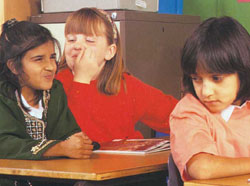|
 |
 |
| |
The focus of this chapter is on relationships with other people, and includes assessment tasks dealing with relationships in classrooms, schools, families and the wider community. Students were asked to show what they understood about how the attitudes, values, actions and needs of people interact, and the influence of social and cultural factors.
Eight tasks were identical for year 4 and year 8 students, one was administered to both years but with minor changes of procedure for year 4 students, one was administered only to year 4 students and one only to year 8 students. Five are trend tasks (fully described with data for both 2002 and 2006), one is a released task (fully described with data for 2006 only) and five are link tasks (to be used again in 2010, so only partially described here).
The tasks are presented in the three sections: trend tasks, then released tasks and finally link tasks. Within each section, tasks administered to both year 4 and year 8 students are presented first, followed by tasks administered only to year 4 students and then tasks administered only to year 8 students.
Many of the tasks were marked both descriptively and evaluatively. Descriptive components explored students’ ideas about issues and their possible solutions, while the evaluative components were ratings of the overall merit of the students’ responses. For some of the tasks, only the evaluative components are included in the comparisons below.
Averaged across 66 task components administered to both year 4 and year 8 students, seven percent more year 8 than year 4 students succeeded with these components. Year 8 students performed better on 80 percent of the components.
Trend analyses showed no meaningful change since 2002 for year 4 students, but a modest improvement for year 8 students. Averaged across 14 task components attempted by year 4 students in both years, two percent more students succeeded in 2006 than in 2002. Gains occurred on nine components and losses on five components. At year 8 level, with 21 task components included in the analysis, five percent more students on average succeeded with the task components in 2006 than in 2002. Gains occurred on 17 components, with losses on two components and no change on two components.
|
